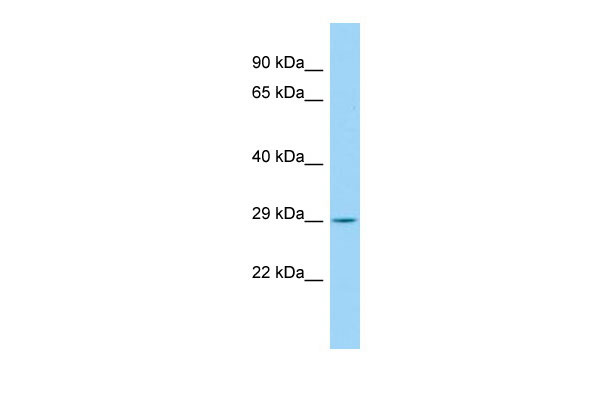CCDC134 Antibody - C-terminal region
Rabbit Polyclonal Antibody
- SPECIFICATION
- CITATIONS
- PROTOCOLS
- BACKGROUND

Application
| WB |
|---|---|
| Primary Accession | Q9H6E4 |
| Other Accession | NM_024821, NP_079097 |
| Reactivity | Human, Mouse, Rat, Rabbit, Horse, Bovine, Guinea Pig, Dog |
| Predicted | Human, Mouse, Rat, Rabbit, Pig, Horse, Bovine, Guinea Pig, Dog |
| Host | Rabbit |
| Clonality | Polyclonal |
| Calculated MW | 25kDa |
| Gene ID | 79879 |
|---|---|
| Alias Symbol | FLJ22349, MGC21013, dJ821D11.3 |
| Other Names | Coiled-coil domain-containing protein 134, CCDC134 |
| Format | Liquid. Purified antibody supplied in 1x PBS buffer with 0.09% (w/v) sodium azide and 2% sucrose. |
| Reconstitution & Storage | Add 50 ul of distilled water. Final anti-CCDC134 antibody concentration is 1 mg/ml in PBS buffer with 2% sucrose. For longer periods of storage, store at 20°C. Avoid repeat freeze-thaw cycles. |
| Precautions | CCDC134 Antibody - C-terminal region is for research use only and not for use in diagnostic or therapeutic procedures. |
| Name | CCDC134 {ECO:0000303|PubMed:39509507, ECO:0000312|HGNC:HGNC:26185} |
|---|---|
| Function | Molecular adapter required to prevent protein hyperglycosylation of HSP90B1: during translation, associates with nascent HSP90B1 and the STT3A catalytic component of the OST-A complex and tethers them to a specialized translocon that forms a microenvironment for HSP90B1 folding (PubMed:38670073, PubMed:39509507). In the CCDC134-containing translocon, STT3A associates with the SRT pseudosubstrate motif of HSP90B1, preventing access to facultative glycosylation sites until folding is completed, preventing hyperglycosylation and subsequent degradation of HSP90B1 (PubMed:39509507). In extracellular secreted form, promotes proliferation and activation of CD8(+) T-cells, suggesting a cytokine- like function (PubMed:25125657). May inhibit ERK and JNK signaling activity (PubMed:18087676, PubMed:23070808). May suppress cell migration and invasion activity, via its effects on ERK and JNK signaling (PubMed:23070808). May also localize in the nucleus: enhances stability of the PCAF histone acetyltransferase (HAT) complex member TADA2A and thus promotes PCAF-mediated histone acetyltransferase activity (PubMed:22644376). Has a critical role in the regulation of osteogenesis and bone development (PubMed:32181939). |
| Cellular Location | Endoplasmic reticulum lumen. Secreted. Cytoplasm Nucleus. Note=Mainly localizes to the endoplasmic reticulum (PubMed:39509507). Accumulates in the nucleus in response to UV irradiation (PubMed:22644376) |
| Tissue Location | Expressed in cervical gland, cervical squamous epithelium, endometrium, stomach, kidney distal convoluted tubule, spermatogenic cells in testis, mammary gland, liver and striated muscle (at protein level) (PubMed:18087676, PubMed:23070808). Also detected in placenta (PubMed:18087676). Highest expression in testis relative to other tissues (PubMed:18087676). Detected in T cells and dendritic cells; highly expressed in activated CD8(+) T cells, and also expressed at lower levels in CD4(+) T cells (PubMed:25125657) |

Thousands of laboratories across the world have published research that depended on the performance of antibodies from Abcepta to advance their research. Check out links to articles that cite our products in major peer-reviewed journals, organized by research category.
info@abcepta.com, and receive a free "I Love Antibodies" mug.
Provided below are standard protocols that you may find useful for product applications.
References
Collins J.E.,et al.Genome Biol. 5:R84.1-R84.11(2004).
Ota T.,et al.Nat. Genet. 36:40-45(2004).
Dunham I.,et al.Nature 402:489-495(1999).
Burkard T.R.,et al.BMC Syst. Biol. 5:17-17(2011).
If you have used an Abcepta product and would like to share how it has performed, please click on the "Submit Review" button and provide the requested information. Our staff will examine and post your review and contact you if needed.
If you have any additional inquiries please email technical services at tech@abcepta.com.













 Foundational characteristics of cancer include proliferation, angiogenesis, migration, evasion of apoptosis, and cellular immortality. Find key markers for these cellular processes and antibodies to detect them.
Foundational characteristics of cancer include proliferation, angiogenesis, migration, evasion of apoptosis, and cellular immortality. Find key markers for these cellular processes and antibodies to detect them. The SUMOplot™ Analysis Program predicts and scores sumoylation sites in your protein. SUMOylation is a post-translational modification involved in various cellular processes, such as nuclear-cytosolic transport, transcriptional regulation, apoptosis, protein stability, response to stress, and progression through the cell cycle.
The SUMOplot™ Analysis Program predicts and scores sumoylation sites in your protein. SUMOylation is a post-translational modification involved in various cellular processes, such as nuclear-cytosolic transport, transcriptional regulation, apoptosis, protein stability, response to stress, and progression through the cell cycle. The Autophagy Receptor Motif Plotter predicts and scores autophagy receptor binding sites in your protein. Identifying proteins connected to this pathway is critical to understanding the role of autophagy in physiological as well as pathological processes such as development, differentiation, neurodegenerative diseases, stress, infection, and cancer.
The Autophagy Receptor Motif Plotter predicts and scores autophagy receptor binding sites in your protein. Identifying proteins connected to this pathway is critical to understanding the role of autophagy in physiological as well as pathological processes such as development, differentiation, neurodegenerative diseases, stress, infection, and cancer.


